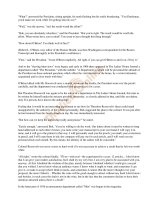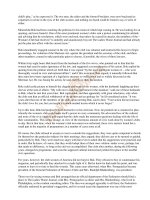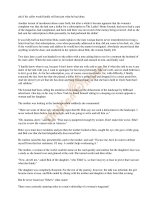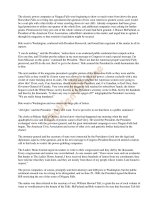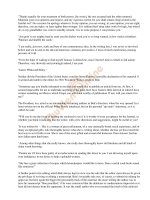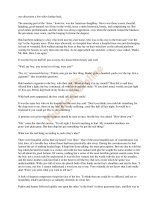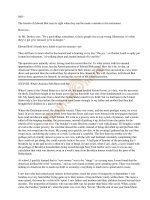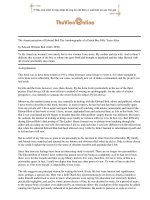The Americanization of Edward Bok 14
Bạn đang xem bản rút gọn của tài liệu. Xem và tải ngay bản đầy đủ của tài liệu tại đây (169.37 KB, 10 trang )
ask if his caller would kindly tell him just what he had done.
Another torrent of incoherent abuse came forth, but after a while it became apparent that the woman's
complaint was that she had sent a dollar for a subscription to The Ladies' Home Journal; had never had a copy
of the magazine, had complained, and been told there was no record of the money being received. And as she
had sent her subscription to Bok personally, he had purloined the dollar!
It was fully half an hour before Bok could explain to the irate woman that he never remembered receiving a
letter from her; that subscriptions, even when personally addressed to him, did not come to his desk, etc.; that
if she would leave her name and address he would have the matter investigated. Absolutely unconvinced that
anything would be done, and unaltered in her opinion about Bok, the woman finally left.
Two days later a card was handed in to the editor with a note asking him to see for a moment the husband of
his irate caller. When the man came in, he looked sheepish and amused in turn, and finally said:
"I hardly know what to say, because I don't know what my wife said to you. But if what she said to me is any
index of her talk with you, I want to apologize for her most profoundly. She isn't well, and we shall both have
to let it go at that. As for her subscription, you, of course, never received it, for, with difficulty, I finally
extracted the fact from her that she pinned a dollar bill to a postal card and dropped it in a street postal box.
And she doesn't yet see that she has done anything extraordinary, or that she had a faith in Uncle Sam that I
call sublime."
The Journal had been calling the attention of its readers to the defacement of the landscape by billboard
advertisers. One day on his way to New York he found himself sitting in a sleeping-car section opposite a
woman and her daughter.
The mother was looking at the landscape when suddenly she commented:
"There are some of those ugly advertising signs that Mr. Bok says are such a defacement to the landscape. I
never noticed them before, but he is right, and I am going to write and tell him so."
"Oh, mamma, don't," said the girl. "That man is pampered enough by women. Don't make him worse. Ethel
says he is now the vainest man in America."
Bok's eyes must have twinkled, and just then the mother looked at him, caught his eye; she gave a little gasp,
and Bok saw that she had telepathically discovered him!
He smiled, raised his hat, presented his card to the mother, and said: "Excuse me, but I do want to defend
myself from that last statement, if I may. I couldn't help overhearing it."
The mother, a woman of the world, read the name on the card quickly and smiled, but the daughter's face was
a study as she leaned over and glanced at the card. She turned scarlet and then white.
"Now, do tell me," asked Bok of the daughter, "who 'Ethel' is, so that I may try at least to prove that I am not
what she thinks."
The daughter was completely flustered. For the rest of the journey, however, the talk was informal; the girl
became more at ease, and Bok ended by dining with the mother and daughter at their hotel that evening.
But he never found out "Ethel's" other name!
There were curiously amusing sides to a man's editorship of a woman's magazine!
The Legal Small Print 136
XXIX. An Excursion into the Feminine Nature
The strangling hold which the Paris couturiers had secured on the American woman in their absolute dictation
as to her fashions in dress, had interested Edward Bok for some time. As he studied the question, he was
constantly amazed at the audacity with which these French dressmakers and milliners, often themselves of
little taste and scant morals, cracked the whip, and the docility with which the American woman blindly and
unintelligently danced to their measure. The deeper he went into the matter, too, the more deceit and
misrepresentation did he find in the situation. It was inconceivable that the American woman should submit to
what was being imposed upon her if she knew the facts. He determined that she should. The process of
Americanization going on within him decided him to expose the Paris conditions and advocate and present
American-designed fashions for women.
The Journal engaged the best-informed woman in Paris frankly to lay open the situation to the American
women; she proved that the designs sent over by the so-called Paris arbiters of fashion were never worn by the
Frenchwoman of birth and good taste; that they were especially designed and specifically intended for "the
bizarre American trade," as one polite Frenchman called it; and that the only women in Paris who wore these
grotesque and often immoderate styles were of the demimonde.
This article was the opening gun of the campaign, and this was quickly followed by a second equally
convincing--both articles being written from the inside of the gilded circles of the couturiers' shops. Madame
Sarah Bernhardt was visiting the United States at the time, and Bok induced the great actress to verify the
statements printed. She went farther and expressed amazement at the readiness with which the American
woman had been duped; and indicated her horror on seeing American women of refined sensibilities and
position dressed in the gowns of the declasse street-women of Paris. The somewhat sensational nature of the
articles attracted the attention of the American newspapers, which copied and commented on them; the gist of
them was cabled over to Paris, and, of course, the Paris couturiers denied the charges. But their denials were
in general terms; and no convincing proof of the falsity of the charges was furnished. The French couturier
simply resorted to a shrug of the shoulder and a laugh, implying that the accusations were beneath his notice.
Bok now followed the French models of dresses and millinery to the United States, and soon found that for
every genuine Parisian model sold in the large cities at least ten were copies, made in New York shops, but
with the labels of the French dressmakers and milliners sewed on them. He followed the labels to their source,
and discovered a firm one of whose specialties was the making of these labels bearing the names of the
leading French designers. They were manufactured by the gross, and sold in bundles to the retailers. Bok
secured a list of the buyers of these labels and found that they represented some of the leading merchants
throughout the country. All these facts he published. The retailers now sprang up in arms and denied the
charges, but again the denials were in general terms. Bok had the facts and they knew it. These facts were too
specific and too convincing to be controverted.
The editor had now presented a complete case before the women of America as to the character of the
Paris-designed fashions and the manner in which women were being hoodwinked in buying imitations.
Meanwhile, he had engaged the most expert designers in the world of women's dress and commissioned them
to create American designs. He sent one of his editors to the West to get first-hand motifs from Indian
costumes and adapt them as decorative themes for dress embroideries. Three designers searched the
Metropolitan Museum for new and artistic ideas, and he induced his company to install a battery of four-color
presses in order that the designs might be given in all the beauty of their original colors. For months designers
and artists worked; he had the designs passed upon by a board of judges composed of New York women who
knew good clothes, and then he began their publication.
The Legal Small Print 137
The editor of The New York Times asked Bok to conduct for that newspaper a prize contest for the best
American-designed dresses and hats, and edit a special supplement presenting them in full colors, the prizes to
be awarded by a jury of six of the leading New York women best versed in matters of dress. Hundreds of
designs were submitted, the best were selected, and the supplement issued under the most successful auspices.
In his own magazine, Bok published pages of American-designed fashions: their presence in the magazine
was advertised far and wide; conventions of dressmakers were called to consider the salability of
domestic-designed fashions; and a campaign with the slogan "American Fashions for American Women" was
soon in full swing.
But there it ended. The women looked the designs over with interest, as they did all designs of new clothes,
and paid no further attention to them. The very fact that they were of American design prejudiced the women
against them. America never had designed good clothes, they argued: she never would. Argument availed
naught. The Paris germ was deep-rooted in the feminine mind of America: the women acknowledged that they
were, perhaps, being hoodwinked by spurious French dresses and hats; that the case presented by Bok seemed
convincing enough, but the temptation to throw a coat over a sofa or a chair to expose a Parisian label to the
eyes of some other woman was too great; there was always a gambling chance that her particular gown, coat,
or hat was an actual Paris creation.
Bok called upon the American woman to come out from under the yoke of the French couturiers, show her
patriotism, and encourage American design. But it was of no use. He talked with women on every hand; his
mail was full of letters commending him for his stand; but as for actual results, there were none. One of his
most intelligent woman-friends finally summed up the situation for him:
"You can rail against the Paris domination all you like; you can expose it for the fraud that it is, and we know
that it is; but it is all to no purpose, take my word. When it comes to the question of her personal adornment, a
woman employs no reason; she knows no logic. She knows that the adornment of her body is all that she has
to match the other woman and outdo her, and to attract the male, and nothing that you can say will influence
her a particle. I know this all seems incomprehensible to you as a man, but that is the feminine nature. You are
trying to fight something that is unfightable."
"Has the American woman no instinct of patriotism, then?" asked Bok.
"Not the least," was the answer, "when it comes to her adornment. What Paris says, she will do, blindly and
unintelligently if you will, but she will do it. She will sacrifice her patriotism; she will even justify a possible
disregard of the decencies. Look at the present Parisian styles. They are absolutely indecent. Women know it,
but they follow them just the same, and they will. It is all very unpleasant to say this, but it is the truth and you
will find it out. Your effort, fine as it is, will bear no fruit."
Wherever Bok went, women upon whose judgment he felt he could rely, told him, in effect, the same thing.
They were all regretful, in some cases ashamed of their sex, universally apologetic; but one and all declared
that such is "the feminine nature," and Bok would only have his trouble for nothing.
And so it proved. For a period, the retail shops were more careful in the number of genuine French models of
gowns and hats which they exhibited, and the label firm confessed that its trade had fallen off. But this was
only temporary. Within a year after The Journal stopped the campaign, baffled and beaten, the trade in French
labels was greater than ever, hundreds of French models were sold that had never crossed the ocean, the
American woman was being hoodwinked on every hand, and the reign of the French couturier was once more
supreme.
There was no disguising the fact that the case was hopeless, and Bok recognized and accepted the inevitable.
He had, at least, the satisfaction of having made an intelligent effort to awaken the American woman to her
The Legal Small Print 138
unintelligent submission. But she refused to be awakened. She preferred to be a tool: to be made a fool of.
Bok's probe into the feminine nature had been keenly disappointing. He had earnestly tried to serve the
American woman, and he had failed. But he was destined to receive a still greater and deeper disappointment
on his next excursion into the feminine nature, although, this time, he was to win.
During his investigations into women's fashions, he had unearthed the origin of the fashionable aigrette, the
most desired of all the feathered possessions of womankind. He had been told of the cruel torture of the
mother-heron, who produced the beautiful aigrette only in her period of maternity and who was cruelly
slaughtered, usually left to die slowly rather than killed, leaving her whole nest of baby-birds to starve while
they awaited the return of the mother-bird.
Bok was shown the most heart-rending photographs portraying the butchery of the mother and the starvation
of her little ones. He collected all the photographs that he could secure, had the most graphic text written to
them, and began their publication. He felt certain that the mere publication of the frightfully convincing
photographs would be enough to arouse the mother-instinct in every woman and stop the wearing of the
so-highly prized feather. But for the second time in his attempt to reform the feminine nature he reckoned
beside the mark.
He published a succession of pages showing the frightful cost at which the aigrette was secured. There was no
challenging the actual facts as shown by the photographic lens: the slaughter of the mother-bird, and the
starving baby-birds; and the importers of the feather wisely remained quiet, not attempting to answer Bok's
accusations. Letters poured in upon the editor from Audubon Society workers; from lovers of birds, and from
women filled with the humanitarian instinct. But Bok knew that the answer was not with those few: the
solution lay with the larger circle of American womanhood from which he did not hear.
He waited for results. They came. But they were not those for which he had striven. After four months of his
campaign, he learned from the inside of the importing-houses which dealt in the largest stocks of aigrettes in
the United States that the demand for the feather had more than quadrupled! Bok was dumbfounded! He made
inquiries in certain channels from which he knew he could secure the most reliable information, and after all
the importers had been interviewed, the conviction was unescapable that just in proportion as Bok had dwelt
upon the desirability of the aigrette as the hallmark of wealth and fashion, upon its expense, and the fact that
women regarded it as the last word in feminine adornment, he had by so much made these facts familiar to
thousands of women who had never before known of them, and had created the desire to own one of the
precious feathers.
Bok could not and would not accept these conclusions. It seemed to him incredible that women would go so
far as this in the question of personal adornment. He caused the increased sales to be traced from wholesaler
to retailer, and from retailer to customer, and was amazed at the character and standing of the latter. He had a
number of those buyers who lived in adjacent cities, privately approached and interviewed, and ascertained
that, save in two instances, they were all his readers, had seen the gruesome pictures he had presented, and
then had deliberately purchased the coveted aigrette.
Personally again he sought the most intelligent of his woman-friends, talked with scores of others, and found
himself facing the same trait in feminine nature which he had encountered in his advocacy of American
fashions. But this time it seemed to Bok that the facts he had presented went so much deeper.
"It will be hard for you to believe," said one of his most trusted woman-friends. "I grant your arguments: there
is no gainsaying them. But you are fighting the same thing again that you do not understand: the feminine
nature that craves outer adornment will secure it at any cost, even at the cost of suffering."
"Yes," argued Bok. "But if there is one thing above everything else that we believe a woman feels and
The Legal Small Print 139
understands, it is the mother-instinct. Do you mean to tell me that it means nothing to her that these birds are
killed in their period of motherhood, and that a whole nest of starving baby-birds is the price of every
aigrette?"
"I won't say that this does not weigh with a woman. It does, naturally. But when it comes to her possession of
an ornament of beauty, as beautiful as the aigrette, it weighs with her, but it doesn't tip the scale against her
possession of it. I am sorry to have to say this to you, but it is a fact. A woman will regret that the mother-bird
must be tortured and her babies starve, but she will have the aigrette. She simply trains herself to forget the
origin.
"Take my own case. You will doubtless be shocked when I tell you that I was perfectly aware of the
conditions under which the aigrette is obtained before you began your exposure of the method. But did it
prevent my purchase of one? Not at all. Why? Because I am a woman: I realize that no head ornament will set
off my hair so well as an aigrette. Say I am cruel if you like. I wish the heron-mother didn't have to be killed
or the babies starve, but, Mr. Bok, I must have my beautiful aigrette!"
Bok was frankly astounded: he had certainly probed deep this time into the feminine nature. With every desire
and instinct to disbelieve the facts, the deeper his inquiries went, the stronger the evidence rolled up: there was
no gainsaying it; no sense in a further disbelief of it.
But Bok was determined that this time he would not fail. His sense of justice and protection to the mother-bird
and her young was now fully aroused. He resolved that he would, by compulsion, bring about what he had
failed to do by persuasion. He would make it impossible for women to be untrue to their most sacred instinct.
He sought legal talent, had a bill drawn up making it a misdemeanor to import, sell, purchase, or wear an
aigrette. Armed with this measure, and the photographs and articles which he had published, he sought and
obtained the interest and promise of support of the most influential legislators in several States. He felt a sense
of pride in his own sex that he had no trouble in winning the immediate interest of every legislator with whom
he talked.
Where he had failed with women, he was succeeding with men! The outrageous butchery of the birds and the
circumstances under which they were tortured appealed with direct force to the sporting instinct in every man,
and aroused him. Bok explained to each that he need expect no support for such a measure from women save
from the members of the Audubon Societies, and a few humanitarian women and bird-lovers. Women, as a
whole, he argued from his experiences, while they would not go so far as openly to oppose such a measure,
for fear of public comment, would do nothing to further its passage, for in their hearts they preferred failure to
success for the legislation. They had frankly told him so: he was not speaking from theory.
In one State after another Bok got into touch with legislators. He counselled, in each case, a quiet passage for
the measure instead of one that would draw public attention to it.
Meanwhile, a strong initiative had come from the Audubon Societies throughout the country, and from the
National Association of Audubon Societies, at New York. This latter society also caused to be introduced bills
of its own to the same and in various legislatures, and here Bok had a valuable ally. It was a curious fact that
the Audubon officials encountered their strongest resistance in Bok's own State: Pennsylvania. But Bok's
personal acquaintance with legislators in his Keystone State helped here materially.
The demand for the aigrette constantly increased and rose to hitherto unknown figures. In one State where
Bok's measure was pending before the legislature, he heard of the coming of an unusually large shipment of
aigrettes to meet this increased demand. He wired the legislator in charge of the measure apprising him of this
fact, of what he intended to do, and urging speed in securing the passage of the bill. Then he caused the
shipment to be seized at the dock on the ground of illegal importation.
The Legal Small Print 140
